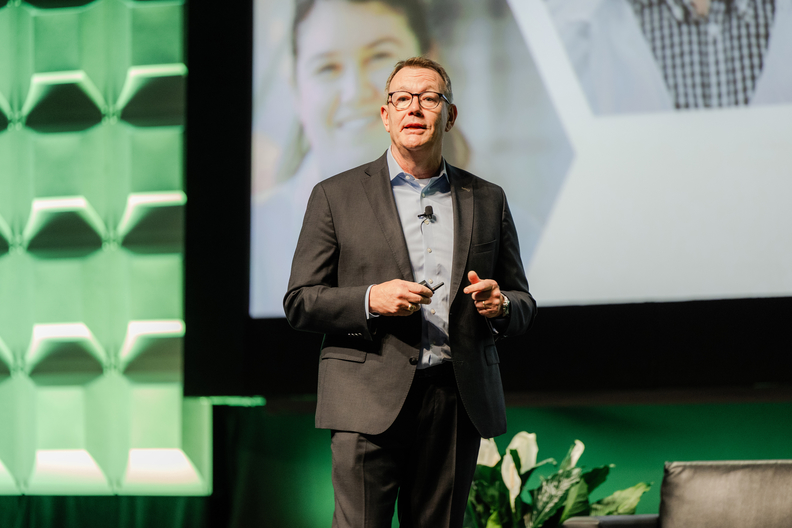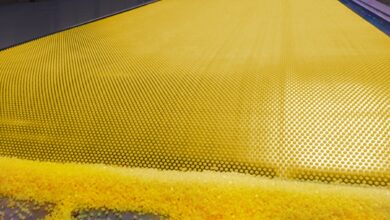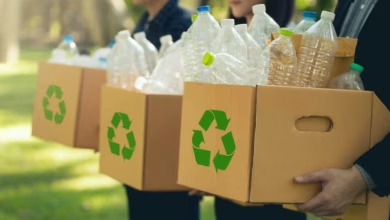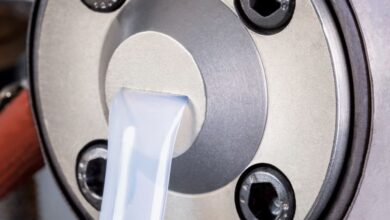
Iranpolymer/Baspar\ Making the plastics industry greener — whether that’s through better recycling or lower carbon footprint manufacturing — will require more from companies, the head of BASF’s North American operations said in an NPE2024 keynote address.
Michael Heinz, chairman and CEO of BASF Corp., kicked off the trade show May 8 with a speech urging industry to be a “bigger part” of solutions.
He called for clearly recognizing the contributions of plastics, like enabling electric cars and wind turbines. But also said industry needs to do more in areas like recycling, noting that only 9 percent of plastics are recycled today.
“As an industry, we are certainly part of the problem. But at the same time, we need to be a bigger part of the solution,” Heinz said. “In order to be a bigger part of the solution, we have to do this together. We have to collaborate along the entire value chain, with NGOs [nongovernmental organizations] and also with lawmakers. Let’s join forces to rethink plastics.”
Since 2021, Heinz has led the 16,000 employees in Florham Park, N.J.-based BASF Corp., the North American wing of Germany’s BASF SE. He’s worked for BASF for more than 40 years and has been on the board of BASF SE since 2011.
The push for sustainability will come with a higher price, though, as companies will need to make capital investments, he warned.
“Some of the technologies that we’re working on today are not economically feasible, so we have to continue to work on that to make it viable,” Heinz said. “Customers have to be willing to pay a higher price because some of the transformation will require a lot of capital.”
Heinz said customers are increasingly on board with forking out more money for green products but added they remain in a minority. He suggested that while a majority say they want more sustainable products, perhaps only 20 percent are willing to pay that premium.
Still, he said, the industry is in a period of change, pointing to the ongoing global plastics treaty negotiations being organized by the United Nations.
Heinz said the treaty discussions now are between two poles: those who want to curb plastic production and those who want to curb plastic pollution, with the industry being in the second camp.
The talks recently wrapped up their fourth of five planned rounds, in Canada in April, with the final session slated for South Korea in late November. He expects countries to reach a deal.
“I think we’ve demonstrated a lot of these ideas which we bring to the table and the feedback from our team, which was in Canada, was actually very positive,” Heinz said. “They believe that we can actually come to a binding agreement in the fall in Korea.”
Greener products
He ran through some of the product offerings BASF was making at NPE to illustrate how the company is trying to green its manufacturing footprint.
Earlier this year, for example, BASF for the first time said it was using feedstock from plastic waste to make monomers using a pyrolysis chemical recycling process, at its BASF TotalEnergies Petrochemicals facility in Port Arthur, Texas.
The company said its Ccycled products — the monomers it makes from chemical recycling — can be used as feedstock to make engineering plastics, super-absorbent plastics and polyurethane foams.
He said building support for that technology, also called advanced recycling, will require significant education of and the public.
“There is a certain myth that pyrolysis oil, which we use in our advanced recycling, that it is part of the incineration process, which it is not,” Heinz said. “We have to educate, educate and educate.”
He said the industry has successfully lobbied 25 U.S. states to pass laws making it easier for chemical recycling plants to operate.
Heinz also pointed to BASF’s Loopamid nylon 6 recycled fibers and a partnership the company had with global fashion retailer Zara to make jackets entirely from recycled nylon.
“Ninety million tons of textile garments have to be dealt with somehow on an annual basis,” he said. “We have a proprietary technology to collect polyamide 6 textile-based fibers, recycle it and bring it back into the loop.
“This jacket was sold out in a matter of hours on the website of Zara in Europe,” he said.
He also said greening BASF’s plastics can reduce the carbon footprint of other companies’ products, pointing to Adidas shoes using BASF thermoplastic polyurethanes that once had 500 grams of carbon dioxide emissions but now have only 270 grams.
By getting its own production down to zero carbon, Heinz said, Adidas could reduce the CO2 impact of its shoes to zero.
Heinz said BASF can supply carbon footprint information on its 45,000 products so its customers can calculate the effects of their products.
As well, he said, BASF is investing in renewable power for its operations.
The company, which is a huge power user with energy needs equal to Greece or Portugal, generates about 50 percent of its own power and is often more efficient in doing that than the national grids it is on, Heinz said.
“When I started with this company, I never would have thought that BASF would own wind parks,” he said, noting that the company owns one of the largest wind parks in Europe, off the coast of the Netherlands.
“We are also right now investing in two more wind parks in the North Sea, in order to get some of that green energy, because we have committed to generating 60 percent of our energy through renewable resources by the year of 2030,” he said.
Heinz suggested that greener products and green manufacturing are now required, and he urged show attendees to take advantage of the tens of thousands of colleagues on-site and “bring out collective minds together” to tackle its challenges.
sustainableplastics






